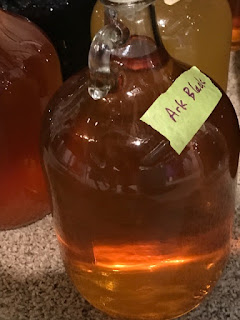A patient brought me 30# of blueberries. The circumstances of the acquisition are suspicious but I didn't ask too many questions.
I already have a straight blueberry and a blueberry rosé in the carboy, so some of these berries are going into a quickie blueberry lemon wine.
This wine will be a quick, early drinker. It is not even worth a chapter, it's pretty cookbook. The rest of the morning was spent remedying various wines which have gone off the track.
Another patient gave me a huge batch of Arkansas Black apples. I pressed them off and made a straight juice, no water, Arkansas Black wine. The wine had been cleared, stabilized, and satisfactorily backsweetened, but it still had a musty smell which kept me from putting it in a bottle. Then I stumbled across this slide deck from Dominique Delteil detailing the use of Noblesse to clean up various problems in wine. The apple got 1g of Noblesse and astonishingly, it is much better. It's more "appley" with a longer finish and little to none of the mustiness it had before. Now I just have to clear it again before bottling.
The problem with the 2016 Blueberry wine was acidity. A pH of 3.07 might be fine for a Sauv Blanc but this wine was like eating a blueberry Sweetart. I've never used any post-ferment KHCO3, but this wine needed help. We bench trialed KHCO3 additions and landed on 1.5g/L. I treated the whole batch and cold stabilized it. Today I racked it; the pH is 3.37 and it is much smoother. I'm not yet sure that I didn't kill the aromatics and make it flabby.
The 2016 Syrah was made from California grapes. This wine has a couple of issues. First, it ended up too light. I should have cold macerated it. But for a light red it will be fine. The bigger problem is a lingering bitterness. The only thing I can think of is that maybe I overpressed it. I fined a portion with bentonite and albumin and it worked as advertised, the bitterness is completely gone! I treated the 5 gallon batch last weekend and today I racked it off the lees, with a plan to bulk age this until next fall. I have 8 gallons, and I intend to bottle some and use the rest for blending with elderberry and Chambourcin.
The biggest problem is the 2016 Lemongrass Mint wine. It developed a slight off odor during fermentation which seemed to improve with splash racking. However, a month later the smell was back, worse than ever. I suspected a H2S problem. I tried the usual splash racking and sulfites, no joy. I then treated it a month ago with Reduless which initially didn't seem to do a thing. I was one step from pitching this wine when today I went back to recheck it and lo and behold, it was much better! Not perfect, but improved. I racked it off the Reduless and dosed it with Noblesse to try to finish the cleanup. My last trick was going to be ascorbic acid and copper, but I may not have to do that.
The rest of the 2016 wines are coming along nicely. I have one more batch of elderberry rosé and that will be about it. It's a good thing, too, because I'm out of carboys and airlocks.
We have one more wave of freezing rain tonight, but we are no longer in the "crippling" zone and based on the appearance of our roof, I'm thinking we dodged a bullet.
 |
| I hope I don't need this |













